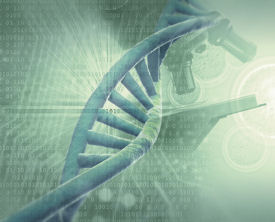It's just old age—or is it? Don't be guided by stereotypes
Would you make the same diagnosis in a 50-year-old patient that you would in an 80-year-old? This and a vague history led one internist to press for a better answer to a patient's anemia and SED rate.
Muthu X. Chandra, FACP, a geriatrician at Kaiser Permanente in Woodland Hills, Calif., told us about the case of an 87-year-old woman referred to his clinic for hospice placement. The patient arrived with her granddaughter, who was a psychologist. Until two years earlier, the woman was an avid golfer and lived alone without assistance, fully able to function. She had developed progressive fatigue and suffered a significant weight loss of 40 lb. Over the proceeding three months, she had become bedridden.
Some 14 physicians had seen the patient and evaluated her for cardiac, pulmonary and neoplastic disorders that might explain her decline. This workup was negative and she was treated with medication for presumed depression, but her status continued to deteriorate.

Dr. Chandra described her as seated in a wheelchair, pale, cachectic and weak. She had just been discharged from the hospital with a urinary tract infection. On physical exam, she had normal vital signs, including O2 saturation, no evidence of congestive heart failure, lymphadenopathy, abdominal masses or edema.
“She looked like she was dying,” Dr. Chandra recalled when we spoke. “But at 87, many look like they are dying.” On laboratory testing, Dr. Chandra noted a normocytic normochromic anemia and an elevated erythrocyte sedimentation rate that had been attributed to her urinary tract infection. He checked for tenderness in the muscles and temporal regions but there was none.
“The family seemed resigned to the eventual outcome and were ready for hospice,” Dr. Chandra said.
“Ageism”
Now, rewrite this history and substitute the age of 45, 55 or 65. Would anyone even consider placing such a patient into hospice care without a diagnosis?
Relying on stereotypes, in this case “ageism,” can lead to attribution errors in clinical thinking. The patient's decline was attributed to “old age” which is, of course, not a diagnosis. Dr. Chandra told the family that hospice placement “made no sense” without an explanation for her current condition.
Time to listen
Dr. Chandra said that the patient complained only of fatigue. She reported a good appetite but was “too tired to eat.” She denied abdominal pain or dysphagia.
“Troubled by her vague history, I spent the next 36 hours between other patients, calling all her caregivers and relatives,” he told us. “Finally, the picture became clear. The patient had resorted to liquid nourishment over the last six months, sucking on a straw because she would get tired from eating.”
Dr. Chandra pursued what she meant by “too tired to eat,” and realized she was describing masseter claudication associated with chewing. “After that, things really fell into place,” he said. The patient had a negative bilateral temporal artery biopsy but treatment with moderate doses of prednisone resulted in a dramatic fall in her sedimentation rate. Within one week, she was walking and eating solid food. “She had a great response to therapy,” Dr. Chandra said.
“History taking from aging patients can be a test of one's patience,” Dr. Chandra said. Finding time to listen to the patient and to obtain input from others, like family and caretakers, is difficult in today's practice of medicine.
Dr. Chandra told us that several years ago, he presented data from his clinic to the administrators of his institution showing that people age 80 and older stayed in the hospital three times as long as 65-year-old patients. He also pointed out statistics from national studies showing that these prolonged stays typically require robust use of inpatient resources. Dr. Chandra argued that the health plan should allow the outpatient visits to be three times as long, and this would translate into reduced hospitalization rates. Indeed, he told us that based on unpublished data, over the next 6 months these patients were hospitalized less often.
Elderly patients now have an initial three-hour consultation with his group, including up to one hour with him. In addition, he and others sometimes make home visits, “to figure it out.” Dr. Chandra has become particularly attentive to language. As we saw in a prior Mindful Medicine case where “lack of stamina” while playing golf meant claudication [ACP Internist, November/December 2008], similarly, in this case, “too tired to eat” meant masseter claudication.
Dr. Chandra particularly focused on the tempo of the patient's decline. “I found it very helpful to know that she was fully active prior to the onset of her symptoms,” he said.
Dr. Chandra recounted. “It probably took me a total of 150 minutes over 36 hours, with many phone calls, to get this right. Now, who in primary care has that kind of time?”
But, clearly in cases like this one, time is essential.




